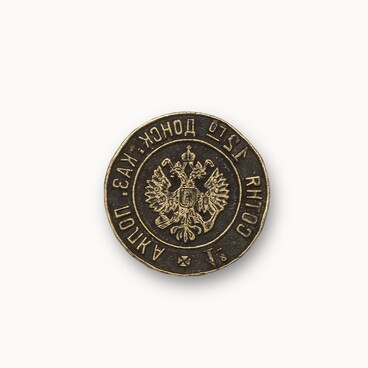In the early 19th century, a new decoration, the medal “For Bravery”, was added to the award system of the Russian Empire. It was awarded to members of irregular forces and units. The medal was also intended for people who did not have an officer or a civil service rank but had distinguished themselves in combat. Moreover, it was awarded “for heroic deeds accomplished when fighting disturbers of peace and wild animals both in time of war and peace.”
Based on the decision by Nicholas II and the new edition of the Statute of the Order of Saint George, in August 1913, the four classes of medals “For Bravery” were attached to this Order and became known as “Saint George Medals”. They were intended for the lower ranks (soldiers, sailors, and non-commissioned officers) for service in the time of peace and war which did not qualify for the Cross of Saint George.
The medal was made of silver and worn on the chest with an orange and black ribbon without a knot, to the right of other decorations. Each recipient was entitled to an annual cash payment depending on the class. A 4th-class medal was accompanied by an annual payment of 12 rubles. A medal could be awarded not only to an individual but also to a military unit: between two and five medals for one troop or sotnia. This is why, during World War I, the Saint George medal became the most common decoration for the lower ranks of the Imperial Russian Army.
Based on the decision by Nicholas II and the new edition of the Statute of the Order of Saint George, in August 1913, the four classes of medals “For Bravery” were attached to this Order and became known as “Saint George Medals”. They were intended for the lower ranks (soldiers, sailors, and non-commissioned officers) for service in the time of peace and war which did not qualify for the Cross of Saint George.
The medal was made of silver and worn on the chest with an orange and black ribbon without a knot, to the right of other decorations. Each recipient was entitled to an annual cash payment depending on the class. A 4th-class medal was accompanied by an annual payment of 12 rubles. A medal could be awarded not only to an individual but also to a military unit: between two and five medals for one troop or sotnia. This is why, during World War I, the Saint George medal became the most common decoration for the lower ranks of the Imperial Russian Army.
The medal is round with a narrow raised edge around the circumference. The obverse shows a sideway image of Nicholas II. The inscription along the rim reads “Б.М. НИКОЛАЙ II ИМП.” on the left and “И САМОД. ВСЕРОСС.” on the right. This is the shortened version of the tsar’s full title “By the Grace of God, Nicholas the Second, Emperor and Autocrat of All Russia”. The reverse features the inscription “For Bravery”, the medal’s number and class.
In his novel “And Quiet Flows the Don”, Mikhail Sholokhov often mentioned that his characters had Saint George Medals “For Bravery”. Characters awarded with these medals included Grandfather Grishaka and Daria Melekhova.




